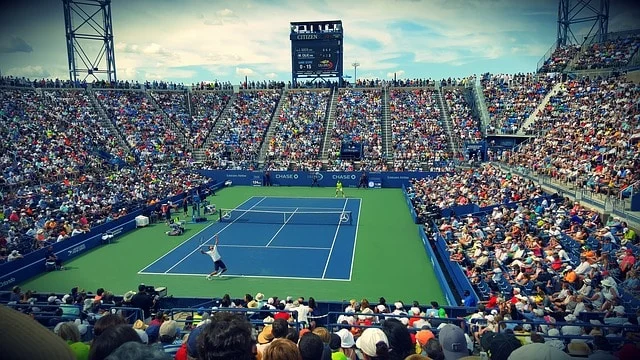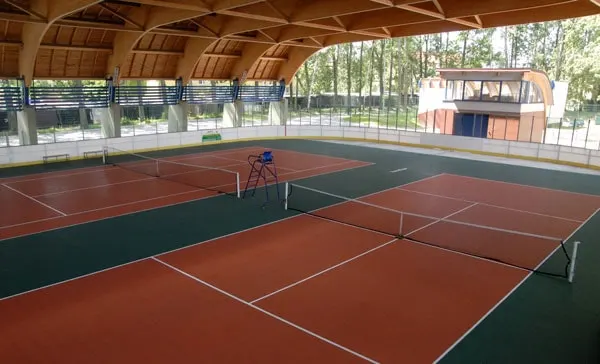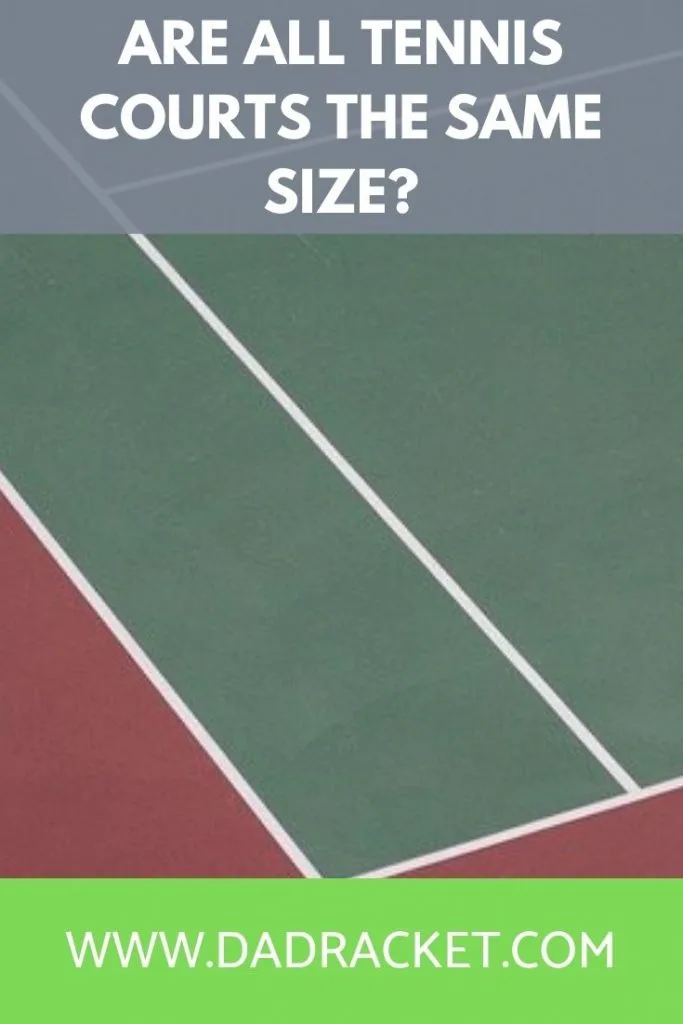
In this blog post we’ll take a look at the standard size of a tennis court, whether they should all be the same size and how much total space is required (including the surrounding area).
The dimensions of a tennis court are regulated and set out by the International Tennis Federation under rule 1 in the ITF Rules Of Tennis. Therefore, all tennis courts should be the same size. The only exceptions to this are for junior courts, ‘real tennis’ courts, or if you’ve decided to build your own customised tennis court at home for recreational use.
What is the size of a standard tennis court?
Here is the standard size for tennis courts in various measurements as set out by the ITF.
..in metres squared?
In metres, the overall length of a tennis court should be 23.77m long. The width for a singles court is 8.23m and 10.97m for doubles. That makes the surface area 195.5m2 for singles and 261m2 for doubles.
..in square footage?
In feet, the length is 78ft, the width for a singles court is 27ft and for doubles it’s 36 ft. The surface for a singles court is 2,106 sq. feet and for doubles it’s 2,808 sq. feet
..in acres?
If you’re thinking of installing a tennis court on your land, you may wish to know the size in acres, For a singles court it’s 0.048 acres and for doubles it’s 0.064.
How wide are the lines on a tennis court?
The doubles tramlines are 4.5 ft (1.37m) wide. From the back of the court to the net, they are 39ft (11.9m) long.
How far apart are the tennis posts?
The net posts are an extra 3ft (0.91m) wide either side of a standard tennis court, so the total width of the net, from post to post should be 42ft (12.8m). For a singles tennis court, the length of the net is 33ft (10m).

Are tennis courts the same size?
Although all professional and recreational courts should be the same size, as defined by the ITF, there are a couple of exceptions.
Junior courts
For junior players, a full-size tennis court is just way too big to play on. Most don’t have the strength to hit with any depth, and certainly not with any control.
In the USA, for very young players, between 4-8 years old, the tennis court is 36ft long and 18ft wide. For 7-10 year olds, it’s considerably longer at 60ft but only slighter wider at 21ft. For 11-12 year olds, they play on a full-size tennis court. These three groups are classified in a colour-coded system; red for very young kids, orange in the middle, and green for the 11-12 year olds.
In the UK, they use the same colour coded approach; red, orange and green with similar court sizes. For the ‘red’ players, the smallest court size works out as half the size of one side of a badminton court, which is quite convenient for maximising space. Therefore, one badminton court can stage 4 singles matches for the under 8’s. For the ‘orange’ players they use a smaller version of a full-size tennis court (these are usually marked on many recreational courts). The total width, including the doubles tramlines, spans the width of a full-size singles court.
Over at Networld Sports, they have some useful diagrams illustrating all the different court sizes for junior tennis.
In your home
Of course, if you have the desire, space and money to install a tennis court in your garden, in theory you can choose what size you want. It would seem strange to do anything other than a standard size…but you never know what some people want in this world!
Real tennis
Real tennis was the original racket sport, and where the modern game of tennis comes from. There are only 48 real tennis courts in the world so it’s quite a challenge to find a court to play on.
Interestingly there are no fixed regulations on what size a real tennis court should be. The majority are about 96ft (29.3m) long and 32ft (9.8m) wide, so they are slightly longer and narrower than standard tennis courts.

What about the space around the tennis court?
Although court sizes are the same size, the space around the tennis court can be different.
Watching the US Open final 2020 last week, I was amazed how far back Dominic Thiem was standing behind the baseline. At my local hard courts, it’s just not possible. In fact, if I’m ever playing someone who hits with heavy topspin, there are times when I’ve been almost touching the side or rear fence to return a heavy ball!
You only need to watch some ATP or WTA events on television to see that there is a lot more space around the courts. It’s certainly an advantage for the professional players who like hitting from the baseline as it gives them more time to return the ball, particularly on serves. However, it’s not only for the players’ benefit to have more space around the edges of the court, there’s a practical reason too. You need an umpire’s chair and space for line judges to stand.
At most levels, clay courts generally have more space around them as the ball kicks up off the surface a lot more.
Here are the recommended dimensions for the total area of a tennis court, including the space around it at the recreational and at the professional level.
| Dimension | International (recommended) | International (minimum) | Recreational (minimum) |
|---|---|---|---|
| Total length | 132ft (40.2m) | 120ft (36.6m) | 114ft (34.8m) |
| Total width | 66ft (20.1m) | 60ft (18.3m) | 56ft (17.1m) |
You can see that at the recommended level for professional tennis courts, the total length is almost 20 ft longer, and 10 ft wider than at the minimum recommended size for recreational tennis courts.
Should tennis courts be bigger?
In other sports, people often debate the size of the pitch in American football, or the size of the goal in soccer, in order to make the game more interesting. In fact, many modern day golf courses are longer to counteract the advancements in golf club technology. Fifty years ago you would never have a player hit a golf ball over 300 yards. Whereas these days, in good conditions, it’s not a big deal for professional players to launch one up the fairway over this distance.
However, should tennis courts be bigger? This was an interesting question posed over at the Tennis Warehouse and it sparked an interesting debate. They even did a poll on this topic

I have to agree with the majority here. I think a bigger court would just benefit the taller players with big serves and make the game more boring. In fact modern day racquets and tennis strings have made it easier to keep the ball in the court with all the topspin players can hit on their shots.
When was the first tennis court made?
Although different to our modern day tennis courts, the first ‘real tennis’ court can be traced back to 1625 at Hampton Court in England. It wasn’t until 1873 that a one Major Walter Clopton Wingfield patented his own version of the game, which was closer to what we play today. However, courts were hourglass shaped, rather than rectangular. In 1875 tennis courts finally matched our current design and the official rules of Lawn Tennis were created. 2 years later, the All England Club held the first Wimbledon tournament.

